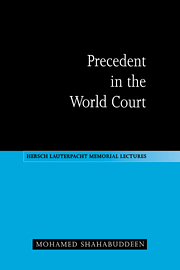Book contents
- Frontmatter
- Contents
- Foreword
- Preface
- List of abbreviations
- 1 Introduction
- 2 The growth of the Court's case law
- 3 Range of precedential resources
- 4 The bases of the system
- 5 The Advisory Committee of Jurists
- 6 The view taken by the League of Nations
- 7 The possibility of judge-made international law
- 8 Stare decisis
- 9 Distinguishing
- 10 Departing from a previous decision
- 11 Ratio decidendi and obiter dictum
- 12 Advisory opinions and decisions of chambers
- 13 The precedential impact of individual opinions
- 14 Effect and scope of the Court's case law
- 15 Conclusion
- Index
10 - Departing from a previous decision
Published online by Cambridge University Press: 04 May 2010
- Frontmatter
- Contents
- Foreword
- Preface
- List of abbreviations
- 1 Introduction
- 2 The growth of the Court's case law
- 3 Range of precedential resources
- 4 The bases of the system
- 5 The Advisory Committee of Jurists
- 6 The view taken by the League of Nations
- 7 The possibility of judge-made international law
- 8 Stare decisis
- 9 Distinguishing
- 10 Departing from a previous decision
- 11 Ratio decidendi and obiter dictum
- 12 Advisory opinions and decisions of chambers
- 13 The precedential impact of individual opinions
- 14 Effect and scope of the Court's case law
- 15 Conclusion
- Index
Summary
Existence of the power to depart from a previous decision
Although stare decisis does not apply, yet, as has been seen in chapter 2, the decision of the Court in one case may be so highly persuasive in another as to excuse language which a lawyer of the common law school may find familiar. In Hersch Lauterpacht's view:
Undoubtedly, so long as the Court itself has not overruled its former pronouncement or so long as States have not, by a treaty of a general character, adopted a different formulation of the law, the ruling formally given by the Court on any question of international law must be considered as having settled, for the time being, the particular question at issue.
That statement, while emphasising that the law on a point must ordinarily be considered as having been settled by a former pronouncement by the Court, makes it clear, however, that such a pronouncement can be ‘overruled’. It is not open to doubt that the Court is at any rate competent to ‘depart’ from a previous decision. Unless it can do so, precedent serves not to broaden but to narrow the development of the law. In the words of Judge Hackworth, ‘It is common knowledge that courts of law and other tribunals, however praiseworthy their intentions may be, are not infallible.
- Type
- Chapter
- Information
- Precedent in the World Court , pp. 128 - 151Publisher: Cambridge University PressPrint publication year: 1996



